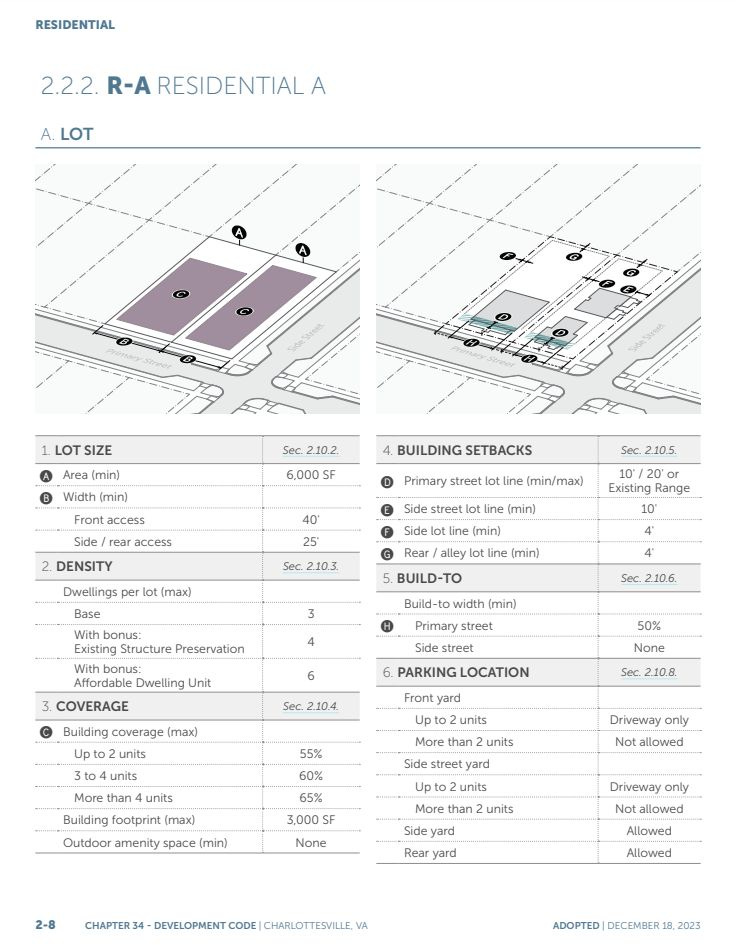March 2024 Charlottesville Transactions: Four properties in "core" neighborhood zoning change hands; New owner for Days Inn on Emmet Street
The 38th monthly look at Charlottesville property transactions intended to educate the writer and anyone else about what's going on
Three years and nearly months have now passed since Charlottesville City Council adopted an affordable housing plan that laid the foundation for a Future Land Use Map which grants more development rights throughout almost the entire city. For instance, properties zoned Residential-A can build two more market-rate units per lot without asking for city approval. That’s a lot of potential wealth for those who understand what they are doing.
However, a last-minute addition to the Development Code last fall was the creation of the Residential Core Neighborhood A zoning district to restrict development rights.
“The Residential Core Neighborhood A (RN-A) district is established in recognition of the significance of historic Downtown neighborhoods that provide workforce housing serving important job centers of Charlottesville’s Downtown and the University of Virginia,” reads page 13 of the Development Code. “These neighborhoods are recognized in the City for their affordability and for the diverse range of households that have been able to make their homes there.”
Properties with this designation are only allowed one unit per lot unless the existing structure is kept. Only then do they get a second. If all of the units are affordable under city definitions, there can be as many as six units.
These properties were first called out for special recognition in the Comprehensive Plan as “Sensitive Communities” that needed protection from gentrification and speculative buying.
“Sensitive Community Areas are places throughout Charlottesville that include concentrations of community members who may be demographically sensitive to displacement pressures and potentially most at risk for displacement,” reads page 27 of the Comprehensive Plan.
The “Sensitive Communities” label was not carried on to the zoning, but the intent is still there.
The proximity of these properties to Downtown Charlottesville and the University of Virginia add an intrinsic value to those who can afford to pay. I’m not sure how to measure such subjective qualities, but I look at every single property transaction in Charlottesville to see how well the philosophies that fueled the Cville Plans Together initiative pan out.

This month, there are four transactions in Residential Core Neighborhood A lots. What happened?
Paid subscribers to my newsletter get a first look as one of the only “premium” pieces of content I offer. In a few days, I’ll post this for free to Information Charlottesville, but putting this work behind a paywall is one way I hopefully entice more paid subscriptions to make sure I can continue to keep doing this work. I believe it is crucial to record the aftermath of the most seismic shift in Charlottesville land use in a generation.
The primary reason I began doing these property transactions a few years ago was to monitor these specific areas after becoming aware of properties being purchased way below assessment. There is a lot of money to be made in property. If one side of a transaction does not have information or information is withheld, the playing field is not equitable.
It is far too early to determine if the new Development Code will yield more affordable units that are not highly subsidized. However, the affordable housing plan morally commits the City Council to spend $10 million a year toward construction and maintenance of new units that will be built by nonprofit developers.
Council has kept up its end of the bargain by awarding both the Piedmont Housing Alliance and the Charlottesville Redevelopment and Housing Authority millions of dollars to help finance the cost of construction of new units. For instance, CRHA is counting on $5 million a year in FY26, FY27, and FY28 to help finance the redevelopment of Westhaven. Piedmont Housing Alliance has several more projects anticipated to be partially financed by city taxpayers. Is this information widely known?
Council’s ability to make direct payments of cash to nonprofit or public developers has been aided by several years of revenue surpluses caused in part by a property market that has had steep assessment increases Council has also increased the real property tax rate by three cents in the past two years. At the tail end of the FY25 budget cycle, elected officials hinted more tax increases are on the way.
We can’t know what Charlottesville will look like in the years to come. We can get a sense of the direction through these property transaction summaries. Thanks to paid subscribers for allowing me to be able to do this work full time. Please ask questions and leave comments below. The whole point of this is to increase awareness of how land use works.



